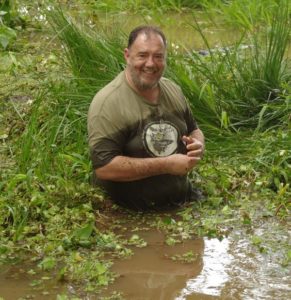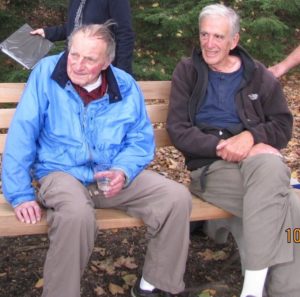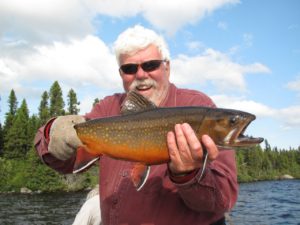2
In the March 1 meeting of the Berkshire County League of Sportsmen’s (BCLS) five area outdoor sportspeople/conservationists were selected to receive awards.
Karen Kruszyna of Cheshire was selected to receive the 2017 Sportsperson of the Year Award. She is a member of many organizations including the Adams Outdoor for Youth (AOFY) and is a Board member of the Cheshire Rod & Gun Club. She does much to get kids of this county outdoors. She is always there to help out at the annual Youth Outreach Fishing Derbies at Reynolds Pond in Cheshire, the BCLS functions such as the Conte Banquet, the AOFY fund raisers and more. She is an avid sportsperson and as you may recall received an award from the Mass Division of Marine Fisheries in 2012 for catching the largest striped bass in the state that year in the women’s category. She was the recipient of BCLS Lifetime Achievement Award and the Massachusetts Sportsmen’s Council 2014 Lillian Gribbons Award. This prestigious award was granted in recognition of Stacy Gribbons’s “tireless efforts of a sportswoman who had dedicated her time, quietly and un-noticed for the benefit of all sportsmen and women of the Commonwealth”.
George Wislocki, of Pittsfield, former president of Berkshire Natural Resource Council (BNRC) was selected to receive the Lifetime Achievement Award. Preserving land was a relatively new idea in the mid 60’s but a group of local leaders and businessmen had ideas of saving lands here in Berkshire County. Starting in 1967 Wislocki helped form the BNRC whose goal is to try and preserve quality open space and protect the ridge lines and wetlands of the Berkshires. The sportsmen of Berkshire County understand the importance of this practice of preserving and protecting open space and large tracts of land.
In 1972, under Georges leadership the BNRC used a new legal tool to protect 1,900 acres owned by the Crane family called Holiday Farm in Dalton. It was one of the state’s first conservation restrictions. Under George’s leadership the BNRC went on to conserve and protect thousands of acres of lands in Western MA, most of which is open to all forms of passive recreation which includes hunting, fishing and trapping. It was in 1973 that the Hallowell family donated 65 acres of their farm on East Street in Lenox to BNRC, stipulating that its natural and scenic character be preserved. I mention this here because that land lies across the road from our home on East Street and can attest to the fact that hunters, hikers and bird watchers have enjoyed that land extensively over the years.
George has been the recipient of numerous awards including the BCLS 1991 Outstanding Achievement Award and the BCLS 2008 Sportsmen’s Appreciation Award.
Dan Miraglia of Pittsfield, has been chosen to receive the Sportsmen’s Appreciation Award. For over 30 years Dan has been working for the sportsmen of Berkshire County and various lake preservation groups by way of an advocate. Most recently he has been an advocate for the fish and critters with regard to the use of herbicides and lake drawdowns. He was past president of the Berkshire County Bass Association, a Housatonic Valley Association stream water quality volunteer, has been involved with river clean-ups and implemented habitat sections of local lakes. In 1996, he was a key person in negotiating agreement between the Pittsfield Conservation Commission and the sportsmen of Berkshire County in stopping the posting of Brattle Brook Park from hunting. Annually, he helps out with the BCLS Youth Outreach fishing derby on Reynolds Pond in Cheshire. In 1998, he was awarded the BCLS Outstanding Achievement Award.
 Tom Tyning, of Pittsfield was selected to receive the Outstanding Achievement Award for his work in the environmental arena. Tom is a Professor of Environmental Science at Berkshire Community College. I Prior to that he attended UMass majoring in Wildlife Biology. From 1975 to 1999 he held a naturalist position with Massachusetts Audubon, moving from Laughing Brook in Hampden to Pleasant Valley and Canoe Meadows in the Berkshires. For most of those years he produced a weekly Nature column for the Springfield Newspapers, wrote A Guide to Amphibians and Reptiles in the Stokes Nature Guide Series, and taught courses at Springfield College and Antioch Graduate School. Eventually he moved into a Master Naturalist position for Audubon working statewide.
Tom Tyning, of Pittsfield was selected to receive the Outstanding Achievement Award for his work in the environmental arena. Tom is a Professor of Environmental Science at Berkshire Community College. I Prior to that he attended UMass majoring in Wildlife Biology. From 1975 to 1999 he held a naturalist position with Massachusetts Audubon, moving from Laughing Brook in Hampden to Pleasant Valley and Canoe Meadows in the Berkshires. For most of those years he produced a weekly Nature column for the Springfield Newspapers, wrote A Guide to Amphibians and Reptiles in the Stokes Nature Guide Series, and taught courses at Springfield College and Antioch Graduate School. Eventually he moved into a Master Naturalist position for Audubon working statewide.
He holds a graduate degree in the Organismic and Evolutionary Biology program with his thesis concentrating on Timber Rattlesnakes in Western MA.
I had the honor of being chosen to receive the John Zuber Award. The late John Zuber was a renowned sportsman’s advocate and conservationist from Pittsfield who passed away in 2012. He was recognized twice by the BCLS (Lifetime Achievement Award and the Sportsman of the Year Award) for his work and dedication to the sportsmen of Massachusetts. He was also recognized by the Massachusetts Sportsmen’s Council and is listed in its Hall of Fame.
John and I became friends through our affiliation with the Pittsfield Sportsmen’s Club and the Taconic Chapter of Trout Unlimited. I treasured his friendship and this award means a lot to me as does my first award from the League, the 1990 Sportsman of the Year Award.
These awards will be presented at the Silvio O. Conte Memorial Awards Dinner at the Cheshire Rod and Gun Club on the evening of April 21. This year the event will also be in honor of the late Edmund Martin “Moose” Ziaja. He was a well-known sportsman from northern Berkshires, an avid hunter, trapper and fisherman. He was a member of The American Trappers Assn., the Brunswick Fox Hunters Association and the Cheshire Rod & Gun Club.
The social hour begins at 5:30 with dinner at 7:00 PM. Tickets which cost $30 can be obtained from any BCLS delegate.
Watch for Eagles
At that above referenced BCLS March meeting, DFW Western Supervisor Andrew Madden requested that we watch for eagles and report local sightings to Andrew. DFW hopes hope to be able to ban some young birds this spring.
Ice fishing season is over
Looks like its time to put away the ice fishing stuff for the year. Although we are still experiencing winter weather, that warm spell a few weeks back really took its toll on the ice thickness. A couple of ice fishermen went through the ice in Laurel Lake during that warm spell. Fortunately, they got out safely. Then we had the snowstorms which put a foot or more snow cover on the thin ice, in effect insulating the lake from the cold weather above. I wouldn’t chance going out on it any more this year.
Incidentally, I received a newspaper article from my niece Linda Craig, who lives out in Minnesota, which local ice fishermen might find interesting. The Minneapolis Star Tribune article was about a $150,000 Ice Fishing Extravaganza recently held on the 9,418-acre Gull Lake near Brainerd, Minnesota. According to the article, an estimated 12,000 anglers took part in the derby which encompassed a 2 square mile fishing area in the Hole-in-the-Day Bay. No wonder the large turnout for the top prize was a new GMC pick-up truck.
Volunteers patrol a cordoned-off area where anglers must fish, but with the presence of so many anglers it makes the task challenging. To be counted for a prize, the fish must be alive when registered. If there is a dispute as to who won or if there is suspicion of possible cheating, they are required to take a lie detector test!
Wow! They take their ice fishing seriously out there.
Fish Kill
MassWildlife informs us that during winter, thick ice and heavy snow cover can result in low dissolved oxygen levels in ponds. With increasing ice and snow packs, there is less light penetration through the water column. This alters chemical and biological processes, often resulting in a winter fish kill.
The vast majority of fish kills turn out to be caused by a natural event. However, it’s important for biologists to rule out other causes including pollution. Natural fish kills are generally the result of low dissolved oxygen levels (anoxia), spawning stress or fish diseases. According to MassWildlife aquatic biologists, dissolved oxygen depletion is one of the most common causes of natural fish kills. Weedy ponds that are less than 15 feet deep are particularly vulnerable. This can be the case at any time of the year but generally occurs during severe winters or late spring/early summer.
Ice anglers may encounter signs of a low oxygen environment when they drill through the ice and notice the smell of rotten egg or observe sluggish or dying shiners. The odor is hydrogen sulfide gas which is a natural byproduct of low dissolved oxygen environments, and is not likely the result of pollution. Oxygen levels will be return to normal shortly after the ice melts in the spring.
If you observe dead fish, contact the Environmental Police’s 24-hour radio room at 1 (800) 632-8075. A MassWildlife biologist will review each situation to determine whether the kill is natural or requires a site investigation.
Firearm Courses
On Tuesday evening, March 20, from 6:00 to 10:00 PM the Lenox Sportsmen’s Club will be hosting a firearms license-to-carry and UTAH Course. The Mass State Police Compliant course will be held at the LSC’s Main Hall, 258 New Lenox Rd, Lenox. The costs are: $70.00 for LTC, $125 for UTAH or $150 for Both.
Pre-registration is required. Contact Dennis Leydet at 413-329-7081 (djleydet@gmail.com) or Tom Nadolny at 413-822-6451 (tnadolny1@gmail.com).
On April 21, the Lee Sportsmen’s Association is hosting a Multi-License Firearm Course. The course qualifies for licenses in MA, CT, UT, FL, ME and NH. For more information call Rob McDermott at 413-232-7700.
Wild & Scenic Film Festival
On Friday evening, March 23, from 6:00 to 9:00 PM, the Berkshire Environmental Action Team (BEAT) will partner with the Wild & Scenic Westfield River Committee to celebrate all things river, in particular the 50th anniversary of the passage of the Federal Wild and Scenic Rivers Act. They will show 2.5 hours of some amazing films celebrating the natural world and the activists working to protect it. The films are billed as inspiring celebrations of environmental leaders, concepts, and design.
The event will take place at Berkshire Community College (K-111)|, 1350 West St. Pittsfield.
This mini film festival is free and open to the public.


